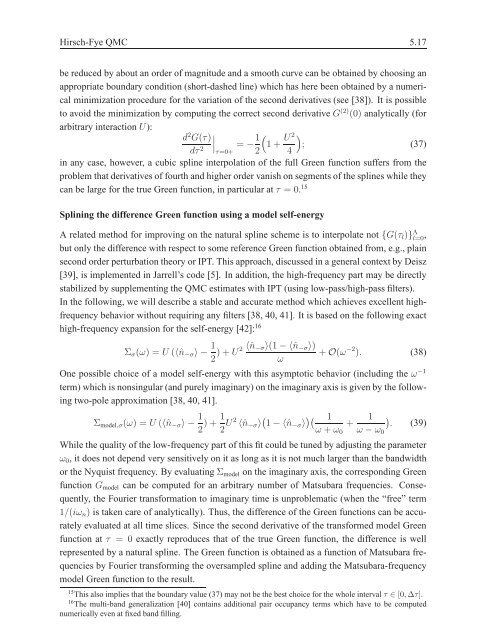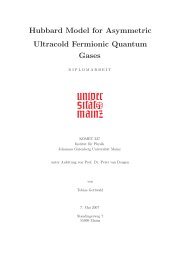5 Hirsch-Fye quantum Monte Carlo method for ... - komet 337
5 Hirsch-Fye quantum Monte Carlo method for ... - komet 337
5 Hirsch-Fye quantum Monte Carlo method for ... - komet 337
Create successful ePaper yourself
Turn your PDF publications into a flip-book with our unique Google optimized e-Paper software.
<strong>Hirsch</strong>-<strong>Fye</strong> QMC 5.17<br />
be reduced by about an order of magnitude and a smooth curve can be obtained by choosing an<br />
appropriate boundary condition (short-dashed line) which has here been obtained by a numerical<br />
minimization procedure <strong>for</strong> the variation of the second derivatives (see [38]). It is possible<br />
to avoid the minimization by computing the correct second derivativeG (2) (0) analytically (<strong>for</strong><br />
arbitrary interactionU):<br />
d2G(τ) dτ2 �<br />
�<br />
� = −<br />
τ=0+<br />
1<br />
�<br />
1+<br />
2<br />
U2<br />
�<br />
; (37)<br />
4<br />
in any case, however, a cubic spline interpolation of the full Green function suffers from the<br />
problem that derivatives of fourth and higher order vanish on segments of the splines while they<br />
can be large <strong>for</strong> the true Green function, in particular at τ = 0. 15<br />
Splining the difference Green function using a model self-energy<br />
A related <strong>method</strong> <strong>for</strong> improving on the natural spline scheme is to interpolate not {G(τl)} Λ l=0 ,<br />
but only the difference with respect to some reference Green function obtained from, e.g., plain<br />
second order perturbation theory or IPT. This approach, discussed in a general context by Deisz<br />
[39], is implemented in Jarrell’s code [5]. In addition, the high-frequency part may be directly<br />
stabilized by supplementing the QMC estimates with IPT (using low-pass/high-pass filters).<br />
In the following, we will describe a stable and accurate <strong>method</strong> which achieves excellent highfrequency<br />
behavior without requiring any filters [38, 40, 41]. It is based on the following exact<br />
high-frequency expansion <strong>for</strong> the self-energy [42]: 16<br />
Σσ(ω) = U (〈ˆn−σ〉− 1 〈ˆn−σ〉(1−〈ˆn−σ〉)<br />
)+U2 +O(ω<br />
2 ω<br />
−2 ). (38)<br />
One possible choice of a model self-energy with this asymptotic behavior (including the ω −1<br />
term) which is nonsingular (and purely imaginary) on the imaginary axis is given by the following<br />
two-pole approximation [38, 40, 41].<br />
Σmodel,σ(ω) = U (〈ˆn−σ〉− 1 1<br />
)+<br />
2 2 U2 〈ˆn−σ〉 � 1−〈ˆn−σ〉 �� 1<br />
+<br />
ω +ω0<br />
1 �<br />
. (39)<br />
ω −ω0<br />
While the quality of the low-frequency part of this fit could be tuned by adjusting the parameter<br />
ω0, it does not depend very sensitively on it as long as it is not much larger than the bandwidth<br />
or the Nyquist frequency. By evaluatingΣmodel on the imaginary axis, the corresponding Green<br />
function Gmodel can be computed <strong>for</strong> an arbitrary number of Matsubara frequencies. Consequently,<br />
the Fourier trans<strong>for</strong>mation to imaginary time is unproblematic (when the “free” term<br />
1/(iωn) is taken care of analytically). Thus, the difference of the Green functions can be accurately<br />
evaluated at all time slices. Since the second derivative of the trans<strong>for</strong>med model Green<br />
function at τ = 0 exactly reproduces that of the true Green function, the difference is well<br />
represented by a natural spline. The Green function is obtained as a function of Matsubara frequencies<br />
by Fourier trans<strong>for</strong>ming the oversampled spline and adding the Matsubara-frequency<br />
model Green function to the result.<br />
15 This also implies that the boundary value (37) may not be the best choice <strong>for</strong> the whole intervalτ ∈ [0,∆τ].<br />
16 The multi-band generalization [40] contains additional pair occupancy terms which have to be computed<br />
numerically even at fixed band filling.













